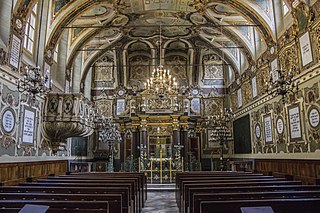
Livorno is a port city on the Ligurian Sea on the western coast of the Tuscany region, Italy. It is the capital of the Province of Livorno, having a population of 158,493 residents in December 2017. It is traditionally known in English as Leghorn.

The Israel Museum is an art and archaeology museum in Jerusalem. It was established in 1965 as Israel's largest and foremost cultural institution, and one of the world's leading encyclopaedic museums. It is situated on a hill in the Givat Ram neighborhood of Jerusalem, adjacent to the Bible Lands Museum, the National Campus for the Archaeology of Israel, the Knesset, the Israeli Supreme Court, and the Hebrew University of Jerusalem.

Museo Galileo is located in Florence, Italy, in Piazza dei Giudici, along the River Arno and close to the Uffizi Gallery. The museum, dedicated to astronomer and scientist Galileo Galilei, is housed in Palazzo Castellani, an 11th-century building which was then known as the Castello d'Altafronte.

Museo Nazionale di San Marco is an art museum housed in the monumental section of the medieval Dominican convent of San Marco dedicated to St Mark, situated on the present-day Piazza San Marco, in Florence, a region of Tuscany, Italy.
David Castelli was an Italian scholar and educator in the field of secular Jewish studies. He was educated at the rabbinical college of Leghorn, and from 1857 to 1863 was teacher of Hebrew and Italian in the Jewish schools of that city. Then he became secretary of the Jewish congregation in Pisa, where at the same time he was a private teacher. From January 1876 until his death he occupied the chair of Hebrew at the Istituto di Studi Superiori Pratici e di Perfezionamento in Florence.

The Jewish Museum of Thessaloniki is a museum in Thessaloniki, Central Macedonia, Greece. It displays the history of Sephardic Jews and Jewish life in Thessaloniki. The museum is being run by the Jewish community of the city.

The Musée d'Art et d'Histoire du Judaïsme or mahJ is the largest French museum of Jewish art and history. It is located in the Hôtel de Saint-Aignan in the Marais district in Paris.

The Great Synagogue of Florence is an Orthodox Jewish congregation and synagogue, that is located at Via Luigi Carlo Farini 4, in Florence, in Tuscany, Italy. Designed in the Italian and Moorish Revival styles, the synagogue was completed in 1882.

The Synagogue of Casale Monferrato is an Orthodox Jewish congregation and synagogue, located at Vicolo Salomone Olper 44, in the Jewish quarter of Casale Monferrato, Province of Alessandria, in the region of Piedmont, Italy. Built in the Piedmontese Baroque and Mannerist styles, the synagogue was completed in 1595.

The Jüdisches Museum Wien, trading as Jüdisches Museum der Stadt Wien GmbH or the Jewish Museum Vienna, is a museum of Jewish history, life and religion in Austria. The museum is present on two locations, in the Palais Eskeles in the Dorotheergasse and in the Judenplatz, and has distinguished itself by a very active programme of exhibitions and outreach events highlighting the past and present of Jewish culture in Austria. The current director is Barbara Staudinger and the chief curator is Astrid Peterle.

The history of the Jews in Florence can be traced over nine hundred years. Florence is the capital city of the Italian region of Tuscany and of the province of Florence. The Jews of Florence have one of the oldest continuous Jewish communities in Europe. The historic Jewish community in Florence is one of the largest and one of the most influential Jewish communities in Italy. The Jewish community in Florence also serves the smaller neighboring Jewish communities in Pisa, Livorno, and Siena.
The following is a timeline of the history of the city of Florence, Tuscany, Italy.
The Jewish Museum “Carlo and Vera Wagner", is located in via del Monte 5/7, Trieste, Italy. It was inaugurated in 1993, by the initiative of Mario Stock together with the generous support of the Wagner-de Polo family.

The Jewish Museum of Rome is situated in the basement of the Great Synagogue of Rome and offers both information on the Jewish presence in Rome since the second century BCE and a large collection of works of art produced by the Jewish community. A visit to the museum includes a guided tour of the Great Synagogue and of the smaller Spanish Synagogue in the same complex.

The Reale Museo di Fisica e Storia Naturale was an Italian museum founded on 22 February 1775 in Florence that survived until 1878, when its collections were split up in various Florentine museums.
The Jewish monumental cemetery in Florence is a monumental cemetery on the current Ariosto avenue, just outside the ancient Renaissance walls, as it was not allowed to bury Jews in the city. It is open once a month, only on last Sundays, with two guided tours in the morning.

The Palace of the Forgotten is a museum in Granada, Spain, dedicated to the Spanish Inquisition, Jewish history, and Granada's and Andalusia's heritage. The building is located in the Albaicín, a neighbourhood declared a World Heritage Site by UNESCO in 1994 as an extension of the monumental complex of the Alhambra and the Generalife.

The Jewish Museum of Venice is a museum focusing on the history of Jews in the city of Venice.

The Umberto Nahon Museum of Italian Jewish Art is a museum dedicated to preserving the heritage, art and culture of the Jews of Italy, located in Jerusalem, Israel. The museum houses cultural and spiritual treasures of Italian Jewry, from the Renaissance to the present day.















